
Pyramids in Fu-sien Lake, China
 4
4
 27. 10. 2016
27. 10. 2016

At the beginning of our century, archaeologists discovered thousands of years old underwater structures in China's deepest lake, Fujian, in the southeastern province of Yunnan. The buildings are megalithic and their architecture can be equal to Egyptian buildings. "Visiting" the city is not easy, it is located at a depth of 81 meters.
The lake is at an altitude of 1 meters, its length is 750 and width is 35 kilometers. In some places it reaches a depth of 7 meters.
The Chinese consider Fu-sien to be sacred, and according to their ancient legends, the bottom of a mysterious lake once inhabited and the Golden City was there. Its inhabitants were rarely allowed to land.
A few years ago, the Chinese army decided to test its new sonar there. To their great surprise, they discovered huge structures by echolocation, some of which resembled pyramids. According to the positions of the scattered stones, they came to the conclusion that the ancient city was either flooded or hit by a strong earthquake. Archaeologist Li Kunsheng, director of the Archaeological Institute of Yunnan University, was the first to describe the lake town.
Lake Fu-sien was found to be of tectonic origin, and the ancient city was built above the fault. The architecture of the pyramids (three so far discovered) is very similar to the Mayan ones and its dimensions are close to the famous buildings in Giza. In general, therefore, archaeologists around the world believe that the underwater city is not part of Chinese culture and cannot be compared to the ancient necropolises of China.
Exploration
In April 2010, an expedition led by Chinese underwater archaeologist Bao Ling, a disciple of Li Kunsheng, was sent to Lake Fu-sien, which had 17 members, two of whom were Russian divers. The survey lasted 10 days, images were taken and samples were taken for further examination by geologists, who were sent to Moscow. At the same time, a short ethnographic survey was carried out around the lake.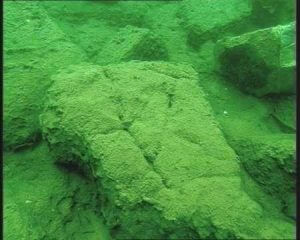
Dives in alpine conditions and at low temperatures in the lake, as well as to a depth of more than 30 meters are not easy. The preparation for the departure of Russian divers took half a year, but most of it concerned the completion of formalities.
The participants of the expedition are convinced that another wonder of the world has been discovered. The explored area at the bottom of the lake with buildings is larger than the once capital of ancient China, the Chan dynasty. It is also interesting that the "lake" city is not mentioned in any known Chinese archives or in ancient manuscripts. The found buildings are megalithic and do not interfere with the Egyptian ones. The stone blocks have dimensions of 3 -5 meters.
Extracts from expeditions
A number of artificial structures are clearly visible at the bottom. The old city is spread over 2,4 square kilometers. The large buildings are basically eight, including two high "stairs" - very similar to the Mayan architecture (including dimensions), and a mysterious circular building. The largest object has a height of approximately 40 meters, its top is 54 and the foundation 97 meters below the surface.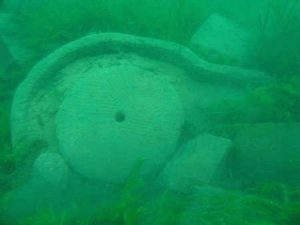
The circular building has a diameter of 37 meters and resembles the Colosseum. The stone blocks are decorated with symbols and some of them resemble buttons.
No residential buildings have been found yet, but we cannot draw conclusions from this. Of the total area of the lake of 222 square kilometers, 2,4 were explored.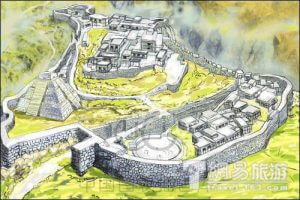
The picture shows the buildings of the lake town, including five recently discovered ones. The buildings are made of worked stone and almost all have signs of earthquake damage. The most magnificent building is a stepped pyramid with sides of about 300 meters and composed of stone blocks of various shapes, on which geometric shapes are visible.
During one of the dives, we discovered, among other things, a very interesting find, the upper part of a ceramic jug. Li Ku, head of the council of experts, commented: "Like this city, there are many places in China where there are Neolithic finds. Similar discoveries are made in the central part of Mongolia, where similar pottery was also found, and this also applies to Europe. "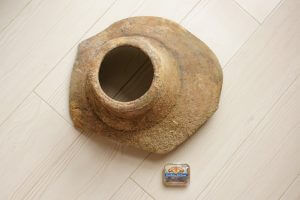
The level of Dian's civilization is comparable to that of Egypt. Several of the artifacts the expedition picked up from the lake were made of an alloy of antimony and copper, proving the level of technology at the time.
I do not think it was anything too mysterious, the "lake" city was on the ancient Silk Road and at the same time at the intersection of the roads of the Dian Empire and the Siamese Kingdom ...
Conclusion - Disobedience
How and why did the ancient buildings in the deep lake actually find themselves? The individual buildings were probably located on the hills and the complex was surrounded by a lake. At that time, its depth was about 30 meters. However, tectonic shifts also caused changes in the earth's crust, and the city, built on a fault, was doomed to landslide to the bottom of the lake. It took place gradually, and therefore the buildings have been preserved. 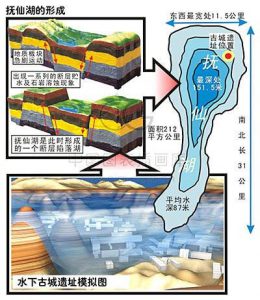
Preliminary findings of an additional ethnographic survey lead to the conclusion that this is a unique culture at Lake Fu-sien.
A sober estimate of old age by Chinese scientists is at least 5 years. The age of 5 - 000 years is mentioned in several other sources. If the age of the underwater city of the Celestial Empire around 12 years were confirmed during the research, it would be another world sensation. Scientists would have to rethink the various stages of human development and accept the fact that there was a highly developed civilization on Earth 000 years ago.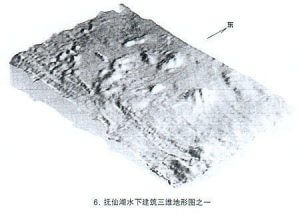
Unfortunately, publicly available official conclusions are not available to date.





